Natural Surfactant from Fatty Acid of Morinda citrifolia L. for Deinking Flotation
Abstract
Natural surfactant is developed as fatty acid derivate from natural resources such as palm oil, sunflower oil, and safflower oil. In South East Asia countries, the palm oil is used as the main resources of fatty acid derivate. Seed oil of Morinda citrifolia L. contains unsaturated fatty acid. It is extracted and concentrated. The concentrated fatty acid of Morinda citrifolia L. (CFAMC) is used as deinking surfactant. The CFAMC is analyzed by GCMS for its constituent and its deinking flotation performance is evaluated for yield, brightness, and ERIC of deinked pulp. Based on the old newspaper (ONP) pulp with brightness of 35.84 °ISO, and ERIC of 1982.4 ppm, the deinking flotation performance of CFAMC is approaching the natural surfactant. The brightness increase is 11.36% and 16.35%, and the ERIC reduction is 37.40% and 47.73% for CFAMC and natural surfactant respectively. SEM analysis is provided to see the residual Nanoink particles on the fibers.References
2. Desai, N., Dattatraya K G., and Chavan, P.D. (2011). Fatty acid profile of seed oil of Morinda species growing in different habitats, Journal of Pharmacy Research, 4(3), 841-842.
3. Dharm, D., Tyagi, C. H., Singh, R. P., and Kumar, A. (2012). Effect of Enzyme Concoctions on Fiber Surface Roughness and Deinking Efficiency of Shorted Office Paper, Cellulose Chemistry and Technology, 46 (9-10), 611-623.
4. Eqbal D., Halimah, A.S., Aminah A. and Zhalifah, M.K., (2011). Fatty acid composition of four difference vegetable oils (Red palm olein, palm olein, corn oil and coconut oil) by gas chromatography, 2nd International Conference on Chemistry and Chemical Engineering, IPCBEE vol. 14, 31-34. Singapore: IACSIT Press.5. Hannuksela, T. and Rosencrance, S. (2008). Deinking Chemistry, Scientific Reports of Working Group Meetings, Kemira Germany GmbH and Kemira Chemicals Inc., unpublished.
6. Jeffries (1994). Comparison of enzyme enhanced with conventional deinking of xerographic and laser-printed paper, Tappi Journal, 77 (4), 173.
7. Khalek, M. A. (2012). Performance of different surfactants in deinking flotation process, Elixir Appl. Chem., 46, 8147-8151.
8. Kim (1991). Enzymatic deinking method of waste paper, Proceeding of Tappi Pulping conference,, 1023 – 1031.
9. Lassus, A. (2000). Recycle Fiber and Deinking, Papermaking Science and Technology, vol. 7, Lothar Göttsching and Heikki Pakarinen ed., Fapet Oy, Finland. 241 – 265.
10. Mayeli and Talaeipour (2010). Effect of difference HLB value and enzymatic treatment on the properties of old newspaper deinked pulp, Bioresources, 5(4), 2520 – 2534.
11. Trismawati, Wardana, I.N.G., Hamidi, N., and Sasongko, M. N. (2015). Characteristic of Flotation Deinking Using Bio and Synthetic Surfactant at Different Air Flow Rate, 4th ICESEAM - International Conference, The Alana Hotel, Surakarta.
12. www.technidyne.com
Copyright holder for articles is ASEAN Journal of Chemical Engineering. Articles published in ASEAN J. Chem. Eng. are distributed under a Creative Commons Attribution-NonCommercial 4.0 International (CC BY-NC 4.0) license.
Authors agree to transfer all copyright rights in and to the above work to the ASEAN Journal of Chemical Engineering Editorial Board so that the Editorial Board shall have the right to publish the work for non-profit use in any media or form. In return, authors retain: (1) all proprietary rights other than copyright; (2) re-use of all or part of the above paper in their other work; (3) right to reproduce or authorize others to reproduce the above paper for authors’ personal use or for company use if the source and the journal copyright notice is indicated, and if the reproduction is not made for the purpose of sale.



